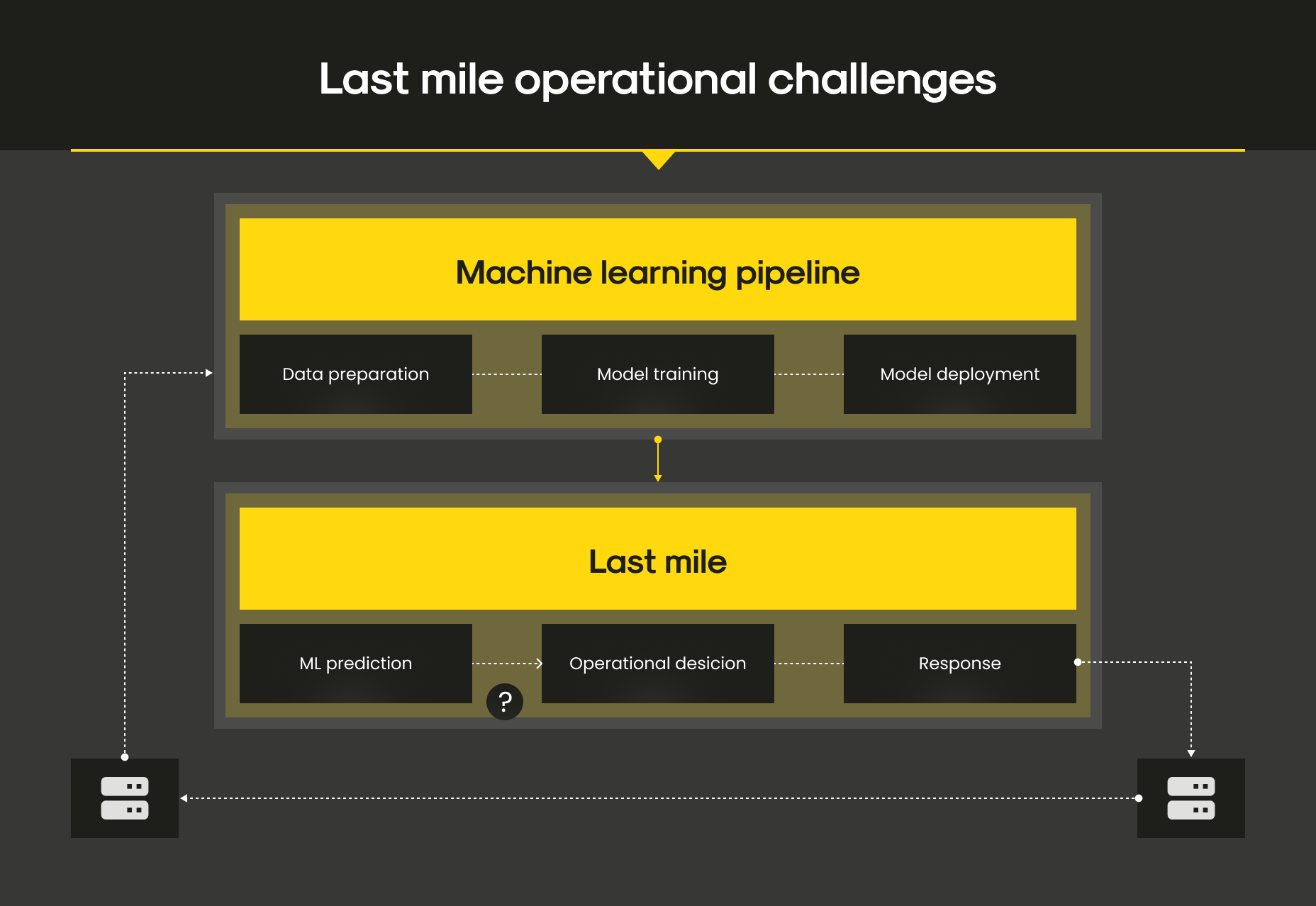It’s not unusual that companies across industries celebrate a working model as the finish line. But in reality, that’s only half the journey. Many organizations invest months training powerful models, only to hit a wall at the deployment stage due to a challenge often called the “last mile” problem in AI adoption. In 2025, AI tools are often regarded as game-changers, but when it comes to real-world workflows, they’ve too often fallen short of delivering lasting impact.
In this article, you will discover:
- Why the last mile in AI adoption has become the pivotal challenge for businesses
- The main hurdles that derail AI from lab success to real-world impact, including integration gaps, data drift, and accountability issues
- A dive into both technical and organizational factors that hinder effective deployment
- Proven strategies to transform AI prototypes into user-ready, production-grade solutions
- How leading organizations are overcoming these barriers to achieve scalable, reliable performance
- And how Mitrix supports businesses in bridging the last mile to turn AI potential into measurable ROI
What is the “last mile” problem?
Let’s start with definitions, shall we? The term comes from logistics, where the last leg of a delivery – getting a package from a warehouse to a doorstep – is the most expensive part. It can, for example, represent as much as 53% of total shipping expenses. In AI, the “last mile” refers to the transition from a model that performs well in testing to one that delivers real value in production.
It’s the gap between:
- A demo-worthy proof of concept and a robust, real-world application
- Offline accuracy metrics and online performance impact
- Data science excitement and business stakeholder buy-in

Last mile operational challenges
In a nutshell, it’s about transforming AI-generated insights into practical, usable solutions that blend effortlessly into day-to-day operations, especially in complex, high-impact settings like healthcare. It’s the critical leap from an impressive prototype to a tool that genuinely drives better outcomes. While data scientists fine-tune models and engineers ensure smooth deployment, the real payoff comes when the technology reaches its final destination: the person who actually needs to use it.
Why AI projects stumble at the last mile
Let’s break down the most common reasons:
1. Lack of integration with business systems
Models aren’t useful if they can’t connect to the systems people already use. Regardless if it’s
CRMs, ERPs, or custom databases, integration is often overlooked until it’s too late. The model might predict customer churn, but if it can’t trigger an automated response in your customer service software, what’s the point?
2. No clear path to action
Insights are only valuable if they lead to action. Many AI projects generate predictions or scores but fail to define what happens next. Who uses the output? What decisions will be made? AI should be embedded into workflows, not tacked on as a report.
3. Data drift and maintenance woes
In the lab, data is clean and stable. In the real world? Not so much. As business processes evolve and user behavior shifts, models degrade. Many organizations lack the monitoring and retraining infrastructure to keep models up-to-date, leading to performance drops and lost trust.
4. Model interpretability issues
Stakeholders often hesitate to trust a black box. If your AI can’t explain itself in business terms, adoption will stall. This is especially true in regulated industries like finance, healthcare, or insurance, where transparency isn’t optional.
5. Ownership and responsibility gaps
Who owns the model after it’s deployed? Is it IT? Data science? Product? This lack of clarity can stall progress. Successful deployment requires cross-functional collaboration and clear accountability for maintaining, monitoring, and improving the system.
Why you need to re-think your delivery strategy
Many businesses attempt to tackle the last-mile AI challenge with brute force: more engineers, more custom code, more time sunk into data wrangling. The instinct is to manually stitch everything together: write bespoke integrations, cleanse data by hand, and rebuild workflows for each new use case.
But this model is deeply flawed:
It’s unscalable. Each AI use case becomes its own mini IT project, demanding months of effort. As systems evolve, previous integrations break, turning maintenance into a full-time job.
It’s unstable. Manually crafted data pipelines are highly sensitive to change. A tweak in one system can trigger cascading failures, and debugging becomes a never-ending chore.
It’s costly. The resources required to build and maintain these custom connections often outweigh the returns from the AI itself. Consequently, they drain budgets and patience.
It’s slow. By the time your AI model is ready for deployment, the problem may have shifted, competitors may have moved faster, or the opportunity may have passed.
In short: the traditional method may get you to the finish line, but not before the race has changed.
Practical strategies to bridge the last mile
Closing the “last mile” in AI adoption is about smarter integration. Once the prototype works in a sandbox, the real challenge begins: embedding AI into live business environments, aligning it with day-to-day operations, and ensuring it delivers consistent, measurable value.
Leading organizations are already showing how it’s done. Below are proven strategies that help translate AI potential into real-world performance. Here’s how smart organizations are closing the gap between lab success and business impact:
1. Start with the business case
Reverse-engineer your AI use case from the business outcome. What decision will be made based on the output? Who needs it? How often? Which system should it integrate with? Think from action to prediction, not the other way around.
2. Treat AI like software
AI isn’t a one-time deliverable: it needs versioning, CI/CD pipelines, observability, and error handling. Use MLOps platforms like
MLflow, Vertex AI, or Seldon to manage the lifecycle of your models.
3. Create a feedback loop
Don’t just deploy and hope. Build in user feedback and outcome tracking from day one. This helps detect data drift, refine the model, and prove ROI to the business.
4. Prioritize explainability
Use techniques like SHAP values, LIME, or natural language summaries to make your model’s decisions interpretable. Frame outputs in terms of business logic, not model confidence scores.
5. Appoint a deployment owner
Assign a product manager or tech lead responsible for “productionizing” AI. They’ll coordinate between data science, engineering, and business teams to ensure the model actually lands where it’s needed.
Why solving the last-mile integration gap is crucial
In short, overlooking last-mile integration jeopardizes AI adoption for business. If tools feel clunky or disrupt established workflows, they simply won’t be used. And if results aren’t measurable, future investments will be harder to justify.
This way, each failed rollout doesn’t just stall progress, but creates skepticism that ripples through the organization. That’s why credibility must be earned not only with engineers and stakeholders, but with the frontline professionals who rely on these systems in real-world scenarios.
To truly realize the promise of AI, organizations need to change how they think about success. That means designing with people in mind, not just algorithms. Cross-functional collaboration is essential: engineers, designers, domain experts, and end users must work together from the start. When integration becomes a priority, we stop treating innovation as the finish line and start focusing on real-world impact.
How Mitrix can help
At Mitrix, we understand that the hardest part of AI isn’t building the model, it’s getting it to work where it actually matters: in your daily operations, with your real data, and for your actual users.
We offer AI/ML and generative AI development services to help businesses move faster, work smarter, and deliver more value. That’s why our approach goes beyond proofs of concept. We specialize in last-mile integration, turning AI prototypes into fully deployed, user-ready systems that deliver measurable value. Here’s how we make that happen:
1. AI Integration
We help you connect AI to your existing systems (CRMs, ERPs, databases, legacy platforms) without overhauling your infrastructure. Our team builds scalable APIs, smart connectors, and automation workflows that let AI tools operate in sync with your business environment.
2. Outcome-focused development
We don’t build AI for the sake of novelty. We co-design solutions with your teams to solve real problems: it helps
reduce manual work, increasing accuracy, and unlocking new capabilities. Every deployment is tied to KPIs that matter to you.
3. Cross-functional expertise
Our teams include engineers, data scientists, designers, and domain specialists who speak both AI and business. This means your solution is not just technically sound, but usable, compliant, and aligned with frontline workflows.
4. Change management & training
AI adoption only succeeds when people trust and understand the system. We work with you to create onboarding materials, run workshops, and build feedback loops that ensure your teams are confident using the technology.
5. Monitoring, optimization & support
Post-deployment, we don’t disappear. We help you monitor model performance, user behavior, and workflow outcomes. Then we iterate and refine the system so it stays relevant as your business evolves.
Here at Mitrix, we turn AI from a promising prototype into a trusted, working part of your business. No more stalled pilots. No more shelfware. Just real AI, solving real problems, in the real world.
Wrapping up
In 2025, building an AI model is no longer the hardest part. The hardest part is getting it deployed successfully. The “last mile” problem isn’t just a technical hurdle, it’s an organizational one. To overcome it, you need alignment between data, systems, and strategy.
AI that doesn’t deliver business value is just a science project. By focusing on deployment strategy early, ensuring integration with operational systems, and building for action (not just accuracy) you can cross the last mile and turn AI into ROI.
This way, companies that crack the last-mile challenge first will gain a serious edge. They’ll roll out AI solutions faster, with fewer hiccups, and without sinking time and budget into endless data preparation.

